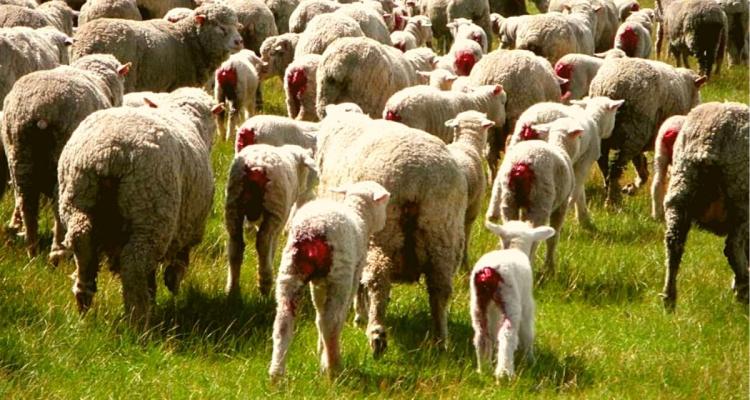Suppose you’ve recently been shopping for Merino wool clothing. In that case, you may have seen the marketing phrase: mulesing-free. It seems like apparel companies are flaunting that word as a central selling point for their clothing. Still, if you’re like most of the general public, you have no idea what is mulesing.
It’s imperative as an ethical consumer that you understand precisely what mulesing is, where it originated from, and how it can affect you. We’ll dive into this highly-debated practice, the process, the ethics, and much more.
But first, we need to take to a brief history lesson.
A Brief Origin of Mulesing & Flystrike
In the later 19th-century, several Merino rams from Vermont were imported into Australia to increase clean wool yield. These studs rapidly spread throughout Australia as woolgrowers hoped to maximize their profits.
At first, the new breeding tactic seemed to work as the crossbred lambs yield weight was high, but it was primarily due to grease weight, not clean weight. On top of that, the wool quality was inconsistent, and the new Merino ewes had much lower lambing percentages. That still wasn’t the worst part; the higher greasy wool content led to a higher rate of parasitic infections like myiasis, also known as flystrike.
In other terms, flies lay larvae in the sheep’s wrinkly skin folds around the breech. The organic excrement – also called dag – provides food for the larvae, and they begin to eat away at the sheep’s flesh. More flies eventually lay more eggs on already-infected sheep. Thus, the slow and painful process continues.
The sheep themselves typically die from ammonia secretions caused by the larvae. According to Vet-Ent New Zealand…
“Once flystrike has been initiated, further flies are attracted to the site, and the sheep can die from ammonia poisoning 3–6 days from the onset of the first strike.”
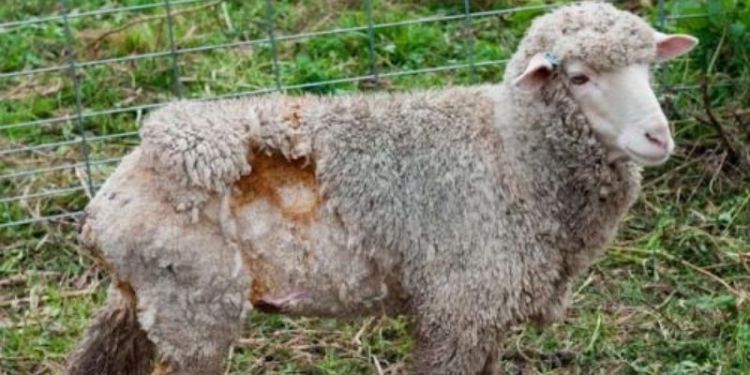
The Accidental Discovery of Mulesing
Now, as you can imagine, a century ago, with minimal technology, the rampant spread of newly-susceptible Merino strains devastated Australia. There was really nothing that could be done about it, and it was a significant problem for farmers’ well-being. That was until, in the early 20th-century, a farmer by the name of John Mules accidentally cut the skin off his sheep’s rear end while shearing it. The resulting scar tissue from the would made the sheep less susceptible to flystrike. Thus, the new process of mulesing was born.
The practice quickly caught on as farmers could better control the prevalence of flystrike among their flocks. Australia adopted the approach in the 1930s as their global wool exports continued to boom.
Although, there is much controversy surrounding mulesing today. We’ll get more into that later. But first, you need to understand the actual procedure of mulesing to form a more educated opinion.
So, Exactly What Is Mulesing?
Mulesing is the removal of skin around a sheep’s buttocks, which in turn forms scar tissue where wool does not grow. Once scarred over, that area does not produce fleece. Thus, it is less likely to hold feces and other organic matter which attract fly larvae that carry the parasitic infection of flystrike.
The process itself is a little gruesome – which is why it’s a controversial agricultural practice. But, you should still understand how it works.
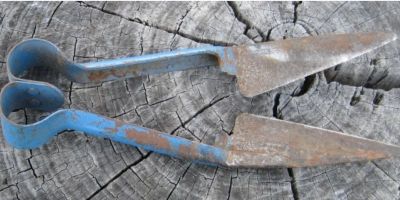
Mulesing Shears. Image Credit: Wikimedia Commons
A sheep is mulesed typically before six months of age. Loose skin around the buttocks is cut around the lamb’s anus with a sharp pair of scissors. Also, the tail is ‘docked’ to a stump to avoid organic matter from becoming stuck in the future. The person administering the treatment (typically a mulesing contractor) then applies a topical painkiller to the surgically removed area.
Sounds painful, right? Well, it gets a bit worse when you find out that no local anesthetic is involved before surgery. Farmers themselves don’t need to visit a licensed veterinarian to perform this procedure. Plus, they typically don’t have deep pockets to shell out money for a medical-grade numbing agent.
If you want to see the process of mulesing in action, you can check the video here. Warning, this video may be troublesome and graphic to some. So, please watch at your own risk.
Mulesing Controversy and Ethics
“Once the sheep have mulesed and let out of the shed and going back to their mothers, they are very stiff. When their wound starts to heal, it gets very sore and they don’t move around very much. You know, they’ve been – they’ve been skinned alive virtually. And, of course they’re in pain.”
Michael Day, Australian Wool Producer
Of course, mulesing’s bloody and outdated practice stirs up controversy in the Merino wool industry. Yet, it’s essential to look at sheep’s welfare from every perspective before jumping to any conclusions.
So, we’ve done our due diligence in providing four different perspectives of the controversial mulesing practice: farmers, animal rights organizations, governments, and you as the end consumer.
The Farmer’s Perspective
Mulesing has often been viewed as a necessary evil within the wool harvesting community. Farmers understand that the process is painful to a lamb, but they also know that a ewe dying from flystrike is painful. However, they aren’t ready to abandon the practice just yet.
“It is quite a blood procedure if you’re not familiar with it, but so are surgical wards.”
David Young, Australian Wool Farmer
Even with animal rights organizations heavily advocating against mulesing, most Australian farmers (70%) are still using the practice. A recent mulesing ban introduced in the NSW state of Australia was met with staunch opposition from NSW Farmers Association. They believe that more sheep will die due to the ban than continuing their current practices.
The other argument for pro-mulesing farmers is that there are not many viable alternatives to mulesing. We’ll get into the specifics in a later section. Still, it’s important to note that this viability is more about money. Other techniques like breeding programs take time and can be expensive.
So, while we may see mulesing reduction with better Merino bloodlines in the future, that’s not exactly the case right now.
Animal Right’s Perspective
As you can imagine, mulesing is heavenly frowned against by animal rights organizations. PETA has put out full ad campaigns against the practice and publicly pressured companies to boycott suppliers who mules sheep. Austrian-based animal rights group Four Paws has recently put out a complete list of companies that don’t source mulesed wool. Even the singer Pink got in the action, speaking on behalf of the sheep.
These organizations have been pushing companies and organizations to boycott farmers and suppliers who still mules their sheep. While we feel that some of their smear tactics go a bit far, their message is sound. Here are just a couple of instances in which animal rights groups have successfully pressure companies to stop sourcing wool from mulesed sheep.
- In 2004, PETA pressured retailer Abercrombie & Fitch to stop sourcing Merino wool from farmers who mules.
- In 2008-2009, fashion companies like Liz Claiborne & John Lewis joined the movement against mulesing.
- Most Swedish retail companies refused to purchase Australian mulesed-wool after a lobbyist was exposed back in 2010.
The Government Perspective
Several countries have taken steps to curb the practice of mulesing in recent years. New Zealand has slowly made mulesing illegal, phasing it out until the law become official in 2018. The United Kingdom also bans mulesing (although most it’s not as popular of a practice due to the low occurrence of flystrike).
These country-wide bans on mulesing have been effective, but again, most global Merino wool is sourced from Australia. And, they don’t have any ban on mulesing. In the early 2000s, Australian Wool Innovation (AWI) pledged to phase out mulesing by 2010, but that was soon dropped after an outcry from farmers.
In New South Wales, the Animal Justice Party introduced legislation to ban mulesing even more recently. Unfortunately, the law was met with heavy opposition from local farmers and has since been tabled.
Overall, for an Australian mulesing ban to actually take place, it’s going to come down to money. It will be about the companies who purchase the wool and the consumers who buy the clothing.
The Consumer Perspective
At the end of the day, consumers have the power to change the practice of Mulesing. For example, if you refuse to buy wool from companies that source their raw material from farmers who mules, then eventually, they’ll have to stop mulesing. It’s simple, really.
As a consumer, you should keep an eye out for one of the three industry organizations that have plead to only use non-mulesed wool.
ZQ Merino: An industry-leading Merino wool supplier in New Zealand focused on the ethical treatment of animals.
Woolmark Certification: While this industry certification does not outright ban mulesing, they have invested heavily in finding safe alternatives to the controversial practice.
The Responsible Wool Standard: This farm-to-fashion standard banned the use of mulesed wool in 2016.
Common Mulesing Alternatives
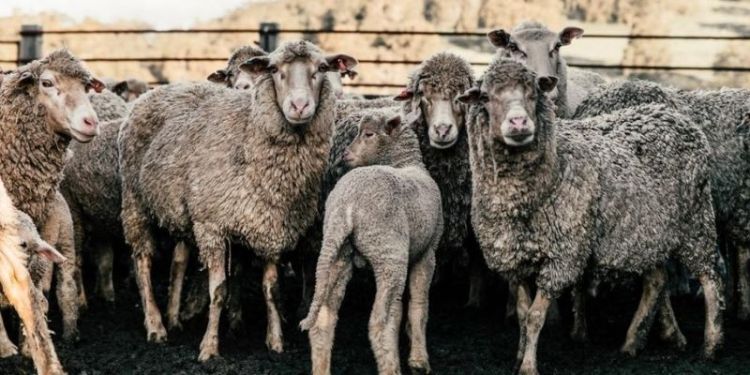
Suppose you see the words’ mulesing-free or ‘non-mulesed as you’re shopping for Merino wool apparel. In that case, you can usually be assured that the wool was sourced from a pain-free process. But, there will always be issues with parasitic infections like flystrike.
So, apart from round-the-clock monitoring of the sheep herd – which farmers can perform with expensive drones – we need to explore some less controversial alternatives.
Biological Engineering & Breeding Programs
“Selective breeding for sheep with a naturally bare and wrinkle-free breech area, resistant to flystrike, is widely considered the best long-term alternative to mulesing.”
– The Commonwealth Scientific and Industrial Research Organization
As with any livestock, Merino sheep are selectively bred to improve specific characteristics across generations. For instance, a ram with a higher fleece weight may be used to create a new bloodline of Merino sheep that produce more fleece.
In other words, think of it like growing vegetables in your garden. You should be planting the seeds from the previous year’s highest-producing plant, as that plant is most likely to produce more giant vegetables again. The same ideology has been used in the selective breeding of livestock for generations.
When it comes to Merino sheep, farmers are selectively breeding rams and ewes that seem to be less susceptible to flystrike. Thus, passing this coveted trait onto future generations. Research has even shown that classifying and breeding sheep based on “wrinkliness” can reduce fly strikes within five years within a single flock.
However, as technology has evolved within the animal husbandry world, scientists can pinpoint genes within DNA, speeding up the selective breeding process.
Topical Protein Treatments
Also known as intradermal injections, topical protein treatments remove wool follicles from a sheep’s backside. A portion of the perineal skin dies, scabs, and falls off. Thus, providing a similar end result to mulesing.
Early scientific research has shown that these treatments, in combination with anesthetic, are less painful to a sheep. There is a needleless application, and it’s basically a similar chemical to botox. However, the main obstacle of these treatments is that there needs to be pharmaceutical approval. Unfortunately to farmers, this is more expensive than established mulesing procedures.
At Merino Wool Gear, we would rather see more money and effort be put into breeding programs to curb flystrike at the source. It’s not about intradermal injection’s effectiveness but more about a long-term solution to avoid physically altering sheep while they are alive.
Crutching
As fly larvae thrive in the wrinkly portions of a sheep’s behind, some farmers choose to regularly shave the wool around this area. This is the process of crutching. While it’s not as effective as mulesing in reducing flystrike, it’s much more ethical for the sheep.
Although, looking at it from a woolgrower’s perspective, having to corral and shave a sheep multiple times a year is not easy. It can be highly time-consuming and expensive.
Steining
The wool industry has developed a steining technique to obtain the same results as mulesing – less fleece around the buttocks. Basically, they use a machine that delivers liquid nitrogen to a sheep’s rear end. The liquid nitrogen’s frigid temperatures freeze off the skin, which scars over and reduces the likelihood of flystrike.
A trained specialist uses an applicator to stretch the sheep’s skin on their breech and quickly applies the liquid nitrogen. Although, early studies have found that steining still may be painful to the sheep, and thus, we can’t put our full support behind the practice. Check out this steining demonstration video for more information
Insecticides
Instead of mulesing the flystrike victims, some experts believe it’s better to control the perpetrators themselves. The use of insecticides has its own ethical and environmental issues, but preliminary research has some promise. Studies have shown that using chemicals to control the fly population reduces Merino sheep’s likelihood of dying from flystrike.
The process itself is called dipping and is recognized in Australia as an alternative to mulesing. The active ingredient in the dip – Cyromazine – is only suited for preventive measures and not as a treatment for flystrike. There are three main dipping methods farmers can use: shower dipping, plunge dipping, and cage dipping.
In the spirit of honesty, we must say that we are not as familiar with the exact process of dipping as with some of the other mulesing alternatives. Therefore, if you would like to learn more, we suggest you check out these dipping best practices from Fly Boss.
Breech Clips
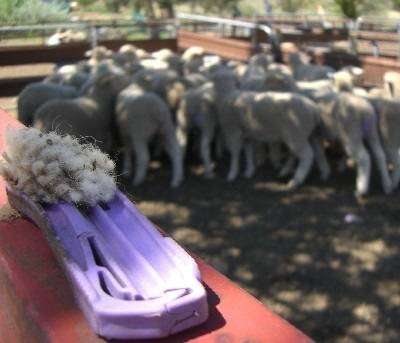
Breech Clips. Image Credit: stockandland.com.au
One way to remove the wool from a Merino’s breach is by using breech clips. These plastic clips are tightly applied to the lamb’s skin, thus cutting off blood flow to the area. Eventually, the skin and the clips fall off, reducing the chance of flystrike.
“The beauty of the clips is what you see is what you get. You can look at the area you’ve applied the clips to and change it if you want, before letting the lamb go.”
Jules Dorrian – AWI Project Manager
The issue with breech clips is that squeezing the skin off of a lamb can still be painful. Early results in the mid-2000s showed some promise of the use of clips. But, we still feel more research needs to be done before calling this process a safe mulesing alternative.
Final Note About Mulesing
At Merino Wool Gear, we believe that there are plenty of viable options and alternatives to Mulesing. As Merino grows as a popular sustainable fabric, consumers need to stand up against the practice of mulesing.
Moreover, keep an eye out for mulesing-free wool standards like ZQ Merino, RWS, and Woolmark. Suppose you have a question about whether or not a Merino wool company sources mulesed wool. In that case, you can check out our company profiles page or simply contact the brand directly.
We can stop this controversial practice by purchasing high-quality, ethical Merino wool. In other words, we collectively have more power as consumers than we may believe.
For more information about Merino wool, ethics, sustainability, and more, check us out on Instagram! Or, continue to read our comprehensive reviews and analysis about our favorite Merino Wool gear!

